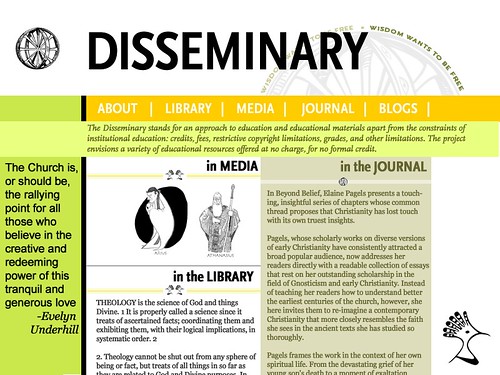Prior Art
I am often wrong, and about lots of things. I am not an oracle.
For that very reason, I feel all the more investment in the things I get right. About seven years ago, I made the first proposal for what we now call the Disseminary to one possible source of funding. I’ve pitched it to other possible sources of support since then; most of the specifics are identical to what the site now says, based on the proposal for which the Wabash Center granted start-up funding two years ago (Thank you, Lucinda and Paul and Tom!).
Among the things toward which that original proposal pointed were podcasting (not under that name, obviously, but it included downloadable audio files, so I’m claiming a hit) and open-access textbooks. Yesterday, Jimbo “Wikipedia” Wales posted the following over at Lawrence Lessig’s blog: “An open project with dozens of professors adapting and refining a textbook on a particular subject will be a very difficult thing for a proprietary publisher to compete with. The point is: there are a huge number of people who are qualified to write these books, and the tools are being created to leave them to do that.” Again, seven years ago I wrote essentially the same thing.
OK, hold down the applause, that’s not the point. The point is that, with the backing of a serious foundation (or private funder), we could get this kind of thing done in the area of theology, an area that’s particularly fitting for educational philanthropy. What we need is the time to devote to open-source scholarly productivity (yesterday I diverted hours from my workflow to track down copyright-safe images for Theology Cards) and the financial support that will motivate scholars to offer their research and written instruction outside the current print-publishing-prestige-profit complex. It can be done in our disciplines, it will be done in some areas of education. Instead of lagging woefully behind the culture, religious educators could vault ahead of other areas of educational culture (with a little redirection of funding that’ll be expended anyway). Trinity Institute, Episcopal Church Foundation, Lilly, Pew, put some oomph behind online theology and it’ll take off. I said so seven years ago, and I still say so. It would be exhilarating if, seven years from now, we could look back and not see just another missed opportunity.


